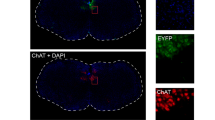Abstract.
In individuals with compromised upper airway anatomy, genioglossus (GG), the main protruder muscle of the tongue, is an important upper airway dilator which helps prevent upper airway obstructions. During rapid eye movement (REM) sleep, both the tonic and inspiratory-modulated components of GG activity are suppressed in parallel with the characteristic postural atonia. We tested whether the REM sleep-related reduction in the respiratory activity of GG may, in part, result from a reduced inspiratory drive relayed to hypoglossal (XII) motoneurons from their premotor medullary inspiratory neurons. In 15 urethane-anesthetized, paralyzed, vagotomized and artificially ventilated rats, we recorded XII nerve activity and the extracellular activity of medullary inspiratory-modulated neurons antidromically activated with latencies of 0.8 ms±0.3(SD) from within (n=19) or adjacent to (n=11) the XII nucleus. Carbachol (10–20 nl, 10 mM), a cholinergic agonist, was microinjected into the dorsomedial pons. Such injections trigger a REM sleep-like state in chronically instrumented, intact animals and, in anesthetized rats, produce respiratory and electrocortical changes similar to those of REM sleep. Following the injections, the respiratory component of XII nerve activity was depressed by 51±22%, while the mean inspiratory firing rate of the neurons decreased by only 7.4±13.8% (from 69±34 Hz to 65±37 Hz; P<0.02; n=30). The activity of ventral respiratory group (VRG) and reticular formation inspiratory neurons with axons within the XII nucleus was reduced by10±14% (P<0.005; n=19), whereas the activity of neurons located near the VRG that had axons passing below the XII nucleus did not change (n=5). Thus, the depressant effect of carbachol on medullary inspiratory neurons was slightly more pronounced in reticular formation and VRG cells premotor to XII motoneurons than in other medullary inspiratory cells. For all cells, the magnitude of the decrease of cell activity was not related to the magnitude of depression of XII nerve activity, the simultaneously occurring decrease in respiratory rate or the cell's control firing rate. Since the magnitude of this depressant effect on all cell types was disproportionately small when compared with the depression of XII nerve activity, the REM sleep-like decrease in GG activity must be mainly mediated by non-respiratory premotor pathways.
Similar content being viewed by others
Author information
Authors and Affiliations
Additional information
Electronic Publication
Rights and permissions
About this article
Cite this article
Woch, G., Ogawa, H., Davies, R. et al. Behavior of hypoglossal inspiratory premotor neurons during the carbachol-induced, REM sleep-like suppression of upper airway motoneurons. Exp Brain Res 130, 508–520 (2000). https://doi.org/10.1007/s002219900244
Received:
Accepted:
Issue Date:
DOI: https://doi.org/10.1007/s002219900244




